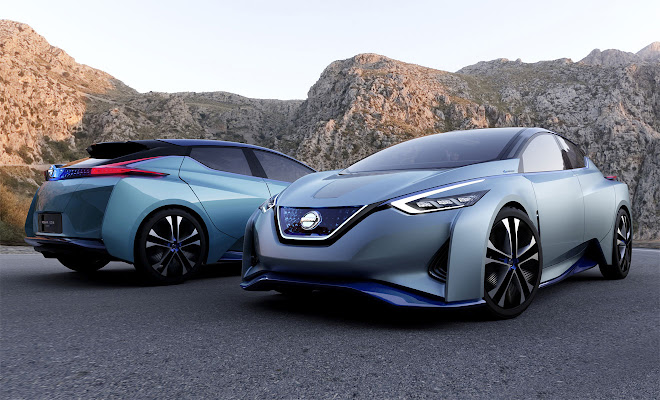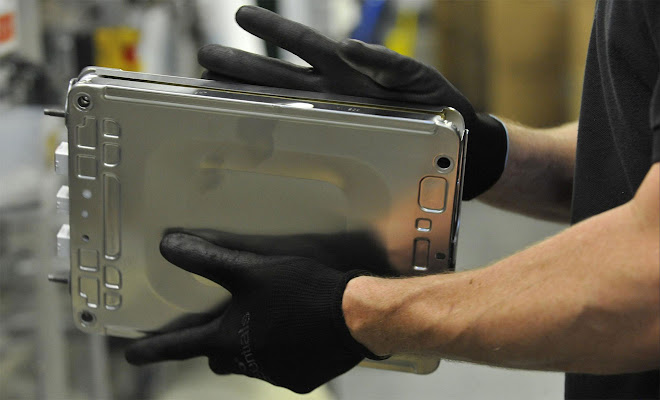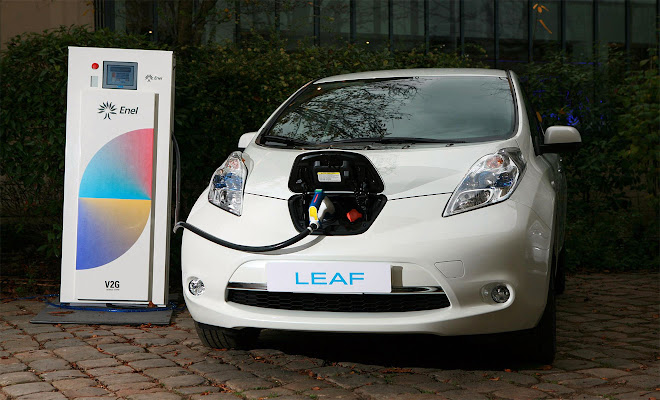by Lem Bingley 
I wouldn’t fancy a job in forecasting in the automotive sector, working out future demand for next-generation cars like the IDS concept above. Manufacturers often appear to be in two minds about the future, sometimes three, and it’s easy to see why. Sales of alternative fuelled vehicles have grown from 2.8% of the UK market in the first four months of 2015 to 3.3% over the same period in 2016. This kind of strong growth from a low base is notoriously hard to project into the future.
On the one hand, we might be poised on the cusp of exponential growth, which would see EVs and plug-ins become a mainstream choice as soon as 2020. On the other, we might see a more modest rate of growth that would keep plug-ins on the periphery for another decade. And on a third hand, we might see any kind of variety of something in between.
These conceptual difficulties were in evidence at the Nissan Futures event held in London yesterday. In one session, focusing on Nissan’s collaboration with architects Foster & Partners, it was suggested that clean energy would become so abundant that it would be free – picked up, stored and redistributed by driverless EVs for the benefit of all. In another session a few minutes later, with speakers from the power industry including National Grid, the topic was the wafer thin margin between energy demand and supply. As a result, owners of big EV batteries might easily profit from storing energy and selling it back to the grid at peak times.

Clearly, both scenarios can’t be true, at least not at the same time. But I know which of those two options I’d put my money on. The first generation of nuclear power stations were once forecast to produce electricity that would be “too cheap to meter” and we all know how well that prediction worked out.
It’s probably fair to say that EV uptake has not progressed at the rate the Renault-Nissan Alliance had in mind when the two companies committed €4bn to electrification in the latter part of the previous decade. Nissan has, however, sold 230,000 examples of its Leaf electric car worldwide since the model was unveiled in 2010, including 50,000 built in the UK.
There are now enough well-used Leafs around for Nissan to fulfil one of its own forecasts from the earliest days of the project – that an EV’s battery would have a second life in static energy storage once the car itself became scrap.
Working with power management company Eaton, Nissan will shortly begin selling xStorage boxes, which contain lithium-ion cells transplanted from old Leafs. With a nominal 6kWh on board, each xStorage unit has roughly a quarter the cell count of a standard Leaf battery.

Because the cells aren’t new, and to eke out their remaining life, the box will only make use of 70% capacity, or 4.2kWh. Nissan says this will let the cells last for at least another 15 years, after which they will need to be broken down and recycled to extract raw materials for some other future use. Lithium, in particular, is a scarce commodity worth hanging onto.
What does a static storage system do? Just as a digital recorder lets you time-shift TV programmes, so a storage system lets you time-shift electricity consumption. Solar panels, for example, peak at lunchtime whereas electricity usage peaks in the early evening, so a box of batteries can better link up supply and demand within a single home. Similarly, you could charge batteries overnight using the economy tariffs offered by energy companies, to avoid drawing from the grid when prices are higher.
On a wider scale, it might be possible to link up networks of xStorage boxes and get the National Grid to pay for helping to stabilise energy supply during times of peak demand, on cold winter evenings. At present, National Grid pays large companies to switch off industrial loads at such times, and xStorage could let consumers grab a piece of that income.

A fully installed xStorage unit will cost about £3,000 when it goes on sale in September, and Nissan says it should pay for itself within five years and generate profits for homeowners over the following decade.
Another Nissan initiative aims to do much the same thing but while the battery is still in the car. Working with power company Enel, it is trialling vehicle-to-grid (V2G) technology. This provides a modified home charging point that allows energy to flow in either direction between the home and car. When not charging the car, the V2G box could instead be powering the home from the car.
The challenge in this scenario is to balance the benefits of power storage with the need to have a full battery whenever you want to jump in and drive somewhere in your Leaf or e-NV200 electric van. Fortunately, as EV batteries become larger, this will become less of an issue – given the scale of benefits that can be gained with only 4.2kWh of xStorage, compared to the 30kWh capacity of the latest Leaf models.
The next generation of Nissan cars will likely vie with the Chevrolet Bolt (or Opel Ampera-e), which will have a 60kWh battery when it goes on sale later this year. The prospect of setting off with a few kWh missing then becomes less of an issue, while longer trips can most likely be scheduled in advance to ensure the car doesn’t power the house on that occasion.

To learn how all this might work in practice, Nissan and Enel have already embarked on a 40-car V2G trial in Denmark and will recruit another 100 participants for a UK trial later this year.
Gathering data will shape the decisions Nissan makes in the future about the promise of vehicle-to-grid. But even with the most diligent trials, it will still require plenty of guesswork when forecasting how V2G might pan out in the real world’s near future.

Nissan reveals home energy storage and vehicle-to-grid plans
11 May 2016
Read more about: electric cars Nissan



